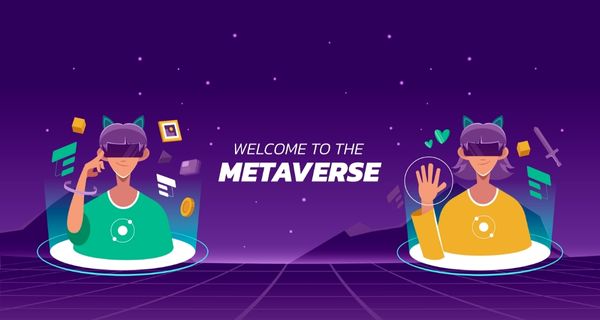The term “metaverse” has transcended science fiction, rapidly becoming a buzzword that encapsulates the next evolution of the internet. It envisions a future where our digital and physical lives seamlessly converge within immersive, interconnected virtual worlds. But what exactly is the metaverse? It’s more than just virtual reality or online gaming; it’s a persistent, shared, and interactive digital space where individuals, represented by avatars, can socialize, work, play, learn, create, and even transact, much like in the physical world.
Imagine a digital realm where you can attend a business meeting as a holographic projection, explore ancient ruins with friends from across the globe, attend a live concert with thousands of others in a virtual stadium, or even try on clothes in a virtual store before making a purchase in the real world. This is the promise of the metaverse – a blurring of the lines between the physical and digital, creating new avenues for human connection, commerce, and creativity.
Sponsored
While the fully realized, unified metaverse remains a future aspiration, various platforms and technologies are laying the groundwork for this transformative shift. Understanding its core concepts, potential benefits, current state, and the platforms leading the charge is crucial for navigating this emerging digital frontier.
Defining the Metaverse: A Tapestry of Interconnected Virtual Worlds
The metaverse isn’t a single application or technology; rather, it’s a confluence of several key elements that together create a sense of presence and shared experience within a digital space. These core characteristics include:
- Immersion: The feeling of being present within the virtual environment, often facilitated by technologies like virtual reality (VR) headsets and augmented reality (AR) glasses. This sense of presence enhances engagement and interaction.
- Social Interaction: The ability for users, represented by avatars, to interact with each other in real-time, fostering a sense of community and shared experience. This can range from casual conversations to collaborative projects.
- Persistence: The metaverse is envisioned as a persistent digital space that continues to exist and evolve even when individual users are not actively participating. This creates a sense of continuity and shared history.
- Spatial Presence: The feeling that other avatars and virtual objects exist in the same digital space as you, contributing to a more natural and intuitive interaction.
- Virtual Economy: Many metaverse platforms incorporate virtual economies where users can create, buy, sell, and trade digital assets, including virtual land, avatars, clothing, and experiences. Cryptocurrencies and NFTs (Non-Fungible Tokens) often play a significant role in these economies.
- Interoperability (Future Goal): While not fully realized yet, the long-term vision includes a degree of interoperability between different metaverse platforms, allowing users and assets to move more seamlessly between virtual worlds.
- User-Generated Content: A key characteristic of many emerging metaverse platforms is the empowerment of users to create and contribute content, from virtual environments and avatars to games and experiences.
The Multifaceted Advantages and Benefits of the Metaverse
The metaverse holds the potential to revolutionize numerous aspects of our lives, offering a wide array of advantages and benefits:
- Enhanced Social Connection: The metaverse can transcend geographical limitations, allowing people from anywhere in the world to connect and interact in shared virtual spaces, fostering new friendships and communities. Individuals with mobility issues or those living in remote areas can experience a greater sense of social inclusion.
- Revolutionizing Communication and Collaboration: Virtual meeting spaces can offer more engaging and interactive experiences than traditional video conferencing. Imagine brainstorming in a shared 3D environment, manipulating virtual objects, and feeling a greater sense of presence with your colleagues, regardless of their physical location.
- Transforming Education and Learning: Immersive educational experiences in the metaverse can bring abstract concepts to life. Students could virtually visit historical sites, dissect a virtual human body, or conduct scientific experiments in a safe and engaging digital environment, leading to deeper understanding and retention.
- New Avenues for Entertainment and Leisure: The metaverse opens up unprecedented possibilities for entertainment, from immersive virtual concerts and sporting events to interactive storytelling and personalized gaming experiences. Users can participate actively in the entertainment rather than passively consuming it.
- Driving Economic Growth and Innovation: The metaverse is creating new digital economies and job opportunities in areas such as virtual asset creation, metaverse development, digital marketing, and virtual event management. The buying and selling of virtual goods and services, often facilitated by blockchain technology, represents a significant economic opportunity.
- Enhancing Accessibility and Inclusion: The metaverse can offer more accessible and inclusive environments for individuals with disabilities. Customizable avatars and virtual spaces can be tailored to meet diverse needs, breaking down physical barriers to participation.
- Virtual Tourism and Exploration: Experience the wonders of the world from the comfort of your home. The metaverse can offer realistic virtual tours of historical sites, museums, and exotic locations, making travel more accessible and sustainable.
- Revolutionizing Retail and Commerce: Virtual storefronts can offer immersive shopping experiences, allowing customers to interact with products in 3D, try on virtual clothing, and receive personalized recommendations. This can bridge the gap between online and physical retail.
- Advancing Training and Simulation: Industries like healthcare, aviation, and manufacturing can leverage the metaverse for realistic and risk-free training simulations, allowing professionals to practice complex procedures and decision-making in immersive virtual environments.
The Future Landscape of the Metaverse: Expectations and Potential
The future of the metaverse is dynamic and full of potential. While the exact trajectory is yet to be fully defined, several key trends and expectations are emerging:
- Increased Immersion and Sensory Integration: Future metaverse experiences will likely involve more sophisticated haptic feedback, allowing users to feel and interact with virtual objects more realistically. Advancements in neural interfaces could even lead to more direct sensory input.
- Enhanced Interoperability and Open Standards: The vision of a truly interconnected metaverse relies on the development of open standards and protocols that allow for seamless movement of avatars, assets, and data between different platforms.
- Greater Realism and Photorealistic Avatars: As technology advances, we can expect more realistic and expressive avatars that better reflect individual identities and emotions.
- Integration of AI and Intelligent Agents: Artificial intelligence will play a crucial role in populating and enriching metaverse environments. AI-powered agents could serve as virtual assistants, guides, or even non-player characters (NPCs) that contribute to dynamic and engaging experiences.
- The Rise of Decentralization and Web3 Integration: Many proponents of the metaverse envision a decentralized and user-owned ecosystem, leveraging blockchain technology and Web3 principles to empower creators and users with greater control over their digital assets and experiences.
- Ubiquitous Access Across Devices: The metaverse will likely be accessible across a wide range of devices, including VR/AR headsets, smartphones, tablets, and traditional computers, blurring the lines between different modes of interaction.
- Hybrid Physical-Digital Experiences: We can expect a greater integration of the physical and digital worlds through augmented reality, where virtual elements are overlaid onto our real-world surroundings, creating blended experiences.
- Specialized Metaverses for Niche Communities: Beyond large, general-purpose platforms, we may see the emergence of specialized metaverses catering to specific interests, industries, or communities.
- Evolving Governance and Regulation: As the metaverse becomes more integrated into our lives, discussions around governance, privacy, safety, and ethical considerations will become increasingly important, potentially leading to new regulations and standards.
The Growing Popularity of the Metaverse: A Convergence of Factors
The recent surge in the metaverse’s popularity can be attributed to a confluence of technological advancements, societal shifts, and strategic investments:
- Advancements in VR and AR Technology: The increasing affordability and sophistication of VR headsets and the growing potential of AR glasses are making immersive metaverse experiences more accessible and compelling.
- The Rise of NFTs and the Creator Economy: Non-fungible tokens have provided a mechanism for digital ownership and monetization, fueling the growth of virtual economies within metaverse platforms and empowering creators.
- Increased Digital Engagement and Online Communities: The COVID-19 pandemic accelerated the trend towards online interaction, making people more comfortable with virtual environments and highlighting the need for richer digital social experiences.
- Strategic Investments by Tech Giants: Major technology companies, such as Meta (formerly Facebook), Microsoft, and Epic Games, are making significant investments in metaverse technologies and platforms, signaling their belief in its future potential.
- Growing Interest from Brands and Businesses: Companies across various industries are exploring the metaverse as a new channel for marketing, commerce, customer engagement, and employee collaboration.
- The Appeal of Novelty and Possibility: The metaverse represents a new frontier for digital exploration and self-expression, capturing the imagination of individuals seeking new ways to connect, create, and experience the digital world.
- The Influence of Gaming and Entertainment: The established success of online gaming platforms with strong social elements has paved the way for the broader adoption of metaverse concepts.
Exploring the Metaverse Platforms: Your Gateways to Virtual Worlds
Now, let’s delve into some of the prominent metaverse platforms you can join today, exploring their unique characteristics, activities, and providing relevant links:
1. Horizon Worlds (Meta)
Link: https://www.meta.com/en-gb/experiences/horizon-worlds/
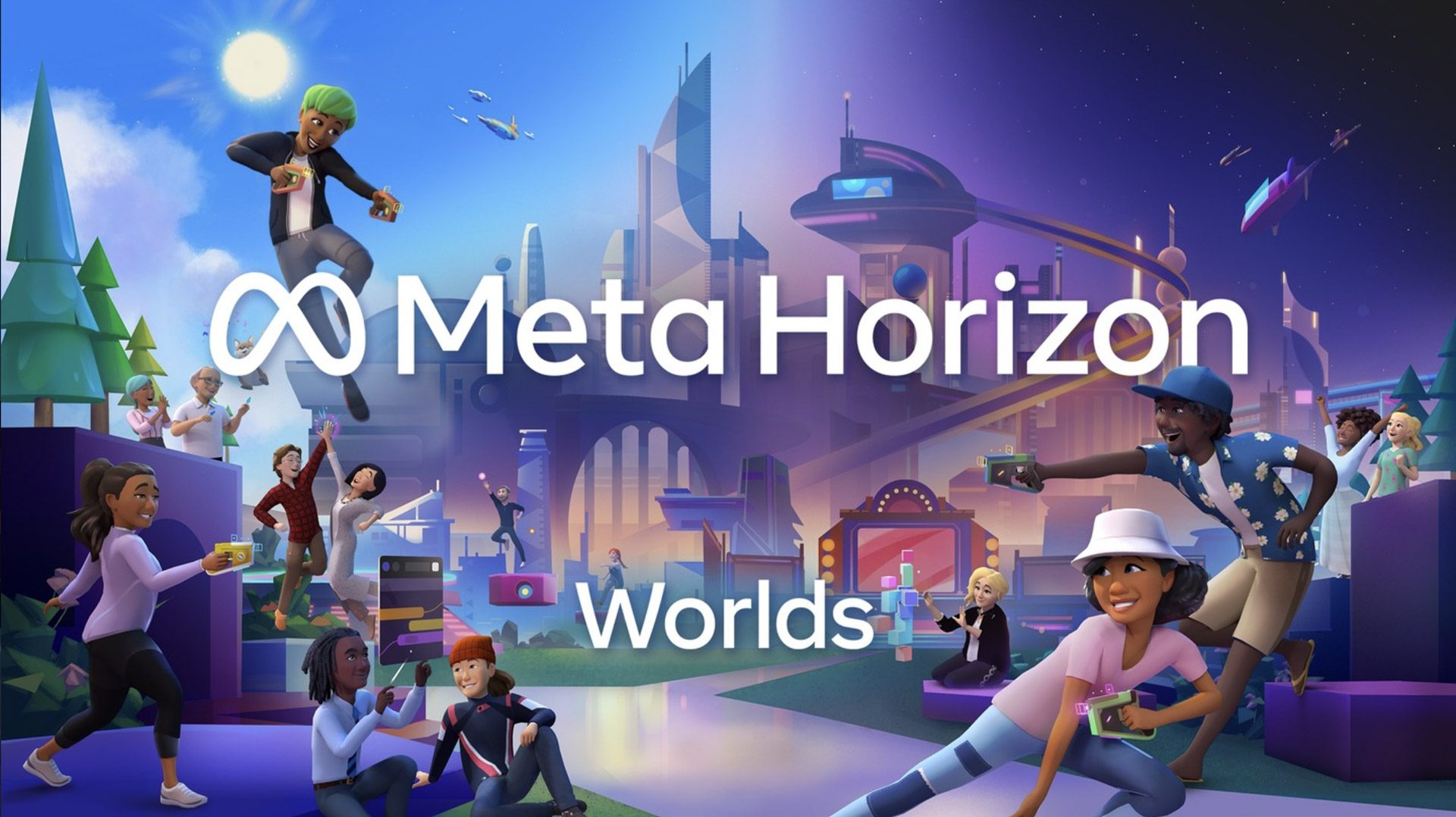
Description: Horizon Worlds is Meta’s flagship social VR platform, designed as a space where users with Meta Quest VR headsets can connect, explore user-created worlds, and participate in a variety of activities. It emphasizes social interaction and creative expression within immersive 3D environments.
Activities:
- Socializing and Meeting People: Horizon Worlds is designed for social interaction. You can meet and interact with other users represented by their customizable avatars in various virtual spaces. Conversations happen through spatial audio, making interactions feel more natural.
- Exploring User-Created Worlds: A core feature of Horizon Worlds is the ability for users to create and share their own virtual worlds using the platform’s built-in creation tools. These worlds can range from social hangouts and games to interactive experiences and artistic installations. You can explore an ever-growing library of these user-generated spaces.
- Playing Games and Participating in Activities: Many user-created worlds feature games and activities designed for multiplayer fun. These can include simple mini-games, collaborative challenges, and more complex interactive experiences.
- Attending Virtual Events: Horizon Worlds hosts various virtual events, such as live music performances, comedy shows, and community gatherings within specific virtual venues. These events offer a shared social experience within the metaverse.
- Creating and Building Worlds: Users with an inclination for creativity can utilize the platform’s intuitive building tools to design and construct their own unique virtual spaces. This involves manipulating shapes, textures, and interactive elements to bring their visions to life.
- Collaborating and Connecting with Communities: Within Horizon Worlds, you can find and join communities based on shared interests, allowing you to connect with like-minded individuals and participate in group activities.
2. VRChat
Link: https://vrchat.com/
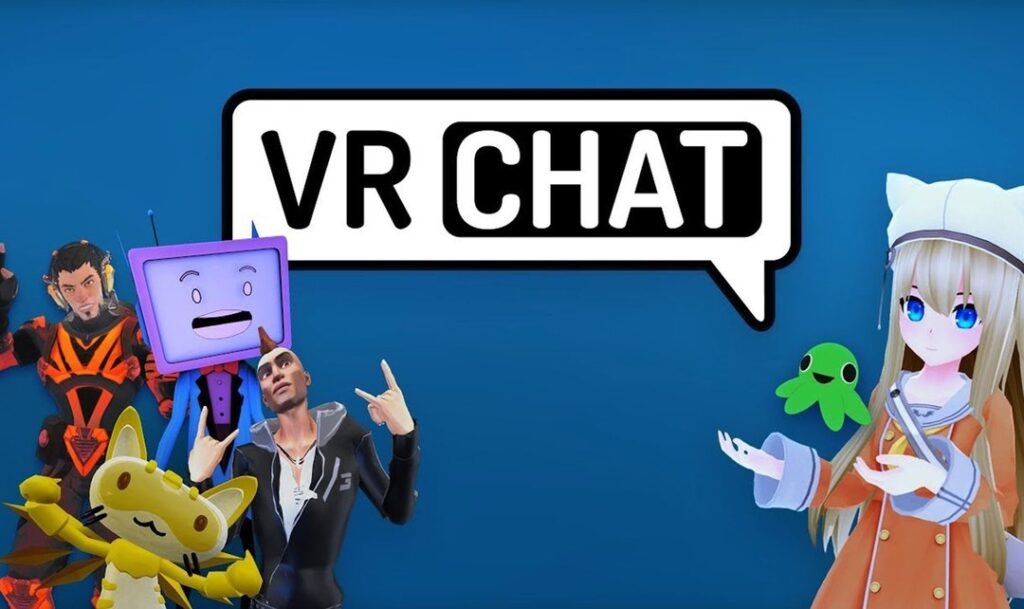
Description: VRChat is a highly popular social VR platform renowned for its incredibly diverse range of user-created avatars and virtual worlds. It supports both VR headsets for an immersive experience and PC access for those without VR. Its open and community-driven nature has fostered a unique and often eccentric social environment.
Activities:
- Unparalleled Avatar Customization: VRChat’s standout feature is its extensive avatar system. Users can create and upload highly detailed and expressive custom avatars, ranging from realistic humanoids to fantastical creatures and even pop culture characters. This freedom of expression is a key draw for many users.
- Exploring a Vast Library of User-Created Worlds: The VRChat community has created an astonishing number of virtual worlds, catering to virtually every interest. You can find social hangouts, role-playing environments, puzzle rooms, scenic landscapes, and much more. Exploring these diverse spaces is a central activity.
- Socializing and Forming Communities: VRChat is fundamentally a social platform. Users gather in virtual worlds to chat, make friends, participate in discussions, and build communities around shared interests, avatars, or even specific virtual spaces.
- Playing Games and Engaging in Activities: Many worlds in VRChat feature interactive elements and games, ranging from simple card games and board games to more elaborate multiplayer experiences like murder mystery or capture the flag.
- Attending Virtual Events and Performances: VRChat hosts a wide variety of user-organized events, including virtual concerts, DJ sets, art exhibitions, and theatrical performances. These events offer unique social and entertainment experiences within the metaverse.
- Role-Playing and Immersive Storytelling: The platform is a popular space for role-playing communities, where users embody characters and participate in collaborative storytelling within specific virtual worlds.
- Learning and Language Exchange: Some communities within VRChat focus on language learning or other educational activities, providing a social and immersive environment for acquiring new skills.
3. Spatial
Link: https://spatial.io/
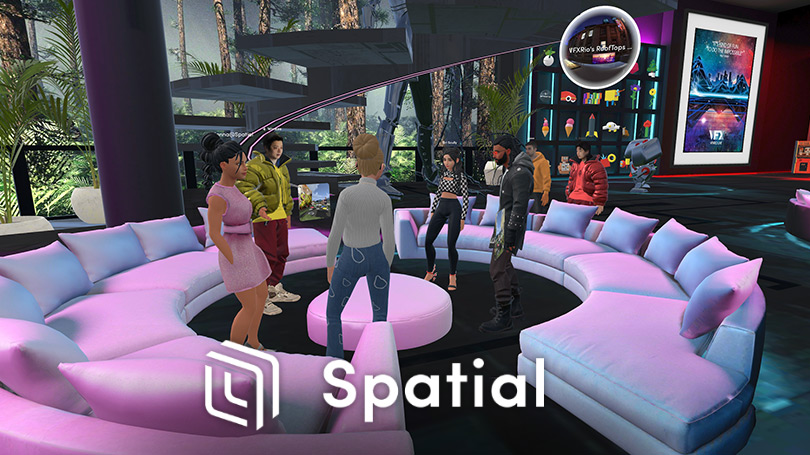
Description: Spatial positions itself as a metaverse platform for culture and commerce, focusing on social events, virtual meetings, and showcasing art and NFTs in immersive 3D spaces. It aims to bridge the gap between the physical and digital worlds, offering accessibility across web browsers, mobile devices, and VR/AR headsets.
Activities:
- Hosting and Attending Virtual Events: Spatial is well-suited for hosting a variety of virtual events, including product launches, art exhibitions, conferences, and social gatherings. Its cross-platform accessibility makes it easy for people to join from different devices.
- Virtual Meetings and Collaboration: Businesses and teams can utilize Spatial for more engaging and interactive virtual meetings. The platform allows for 3D presentations, collaborative whiteboarding, and a greater sense of presence among participants.
- Showcasing Art and NFTs: Artists and collectors can create immersive virtual galleries to display and sell their digital art and NFT collections. The platform provides tools for curating and presenting these assets in visually appealing 3D environments.
- Socializing and Networking: Spatial offers virtual spaces for users to connect, socialize, and network. Its focus on professional and creative communities makes it a valuable platform for building connections within specific industries.
- Creating and Customizing Virtual Spaces: Users can customize their own virtual spaces to host events, showcase their work, or simply create personalized social environments. The platform offers a range of customization options.
- Integrating with Web3 and Digital Assets: Spatial has a strong focus on integrating with the Web3 ecosystem, allowing users to easily display and interact with their NFTs and other digital assets within their virtual spaces.
- Augmented Reality Experiences: Beyond VR, Spatial also explores augmented reality applications, allowing users to bring virtual elements into their physical surroundings for blended experiences.
4. Second Life
Link: https://secondlife.com/
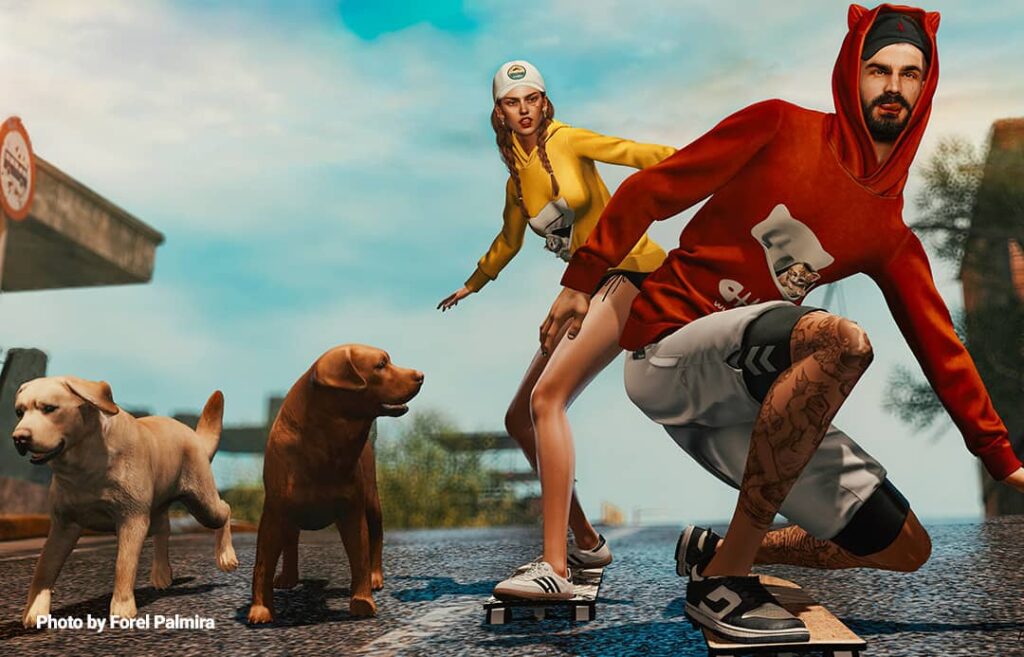
Description: Launched in 2003, Second Life is one of the oldest and most established virtual worlds, often considered a foundational metaverse platform. It offers a persistent, user-created world with a strong emphasis on social interaction, virtual real estate, and a thriving virtual economy powered by its own currency, Linden Dollars (L$).
Activities:
- Socializing and Building Communities: Second Life has a long-standing and diverse community of users who connect based on shared interests, forming groups and organizing events. Social interaction remains a core activity.
- Exploring a Vast and Diverse User-Created World: Over its long history, Second Life users have created an incredibly rich and diverse landscape of virtual environments, from bustling cities and scenic landscapes to fantasy realms and historical recreations. Exploration is a key part of the experience.
- Creating and Trading Virtual Goods: Second Life has a well-established virtual economy where users can create and sell a wide range of digital goods, including avatars, clothing, furniture, buildings, and scripts. This creator-driven economy is a defining feature.
- Owning and Developing Virtual Land: Users can purchase virtual land in Second Life and develop it according to their preferences, building homes, businesses, or community spaces. Virtual real estate is a significant aspect of the platform’s economy.
- Attending Live Events and Performances: Second Life hosts a wide array of virtual events, including live music concerts, DJ sets, theatrical performances, art exhibitions, and educational seminars.
- Role-Playing and Immersive Experiences: The platform is a popular space for role-playing communities spanning various genres, offering immersive storytelling and character embodiment.
- Learning and Education: Many educational institutions and organizations have a presence in Second Life, using it for virtual lectures, simulations, and collaborative learning environments.
5. Roblox
Link: https://www.roblox.com/
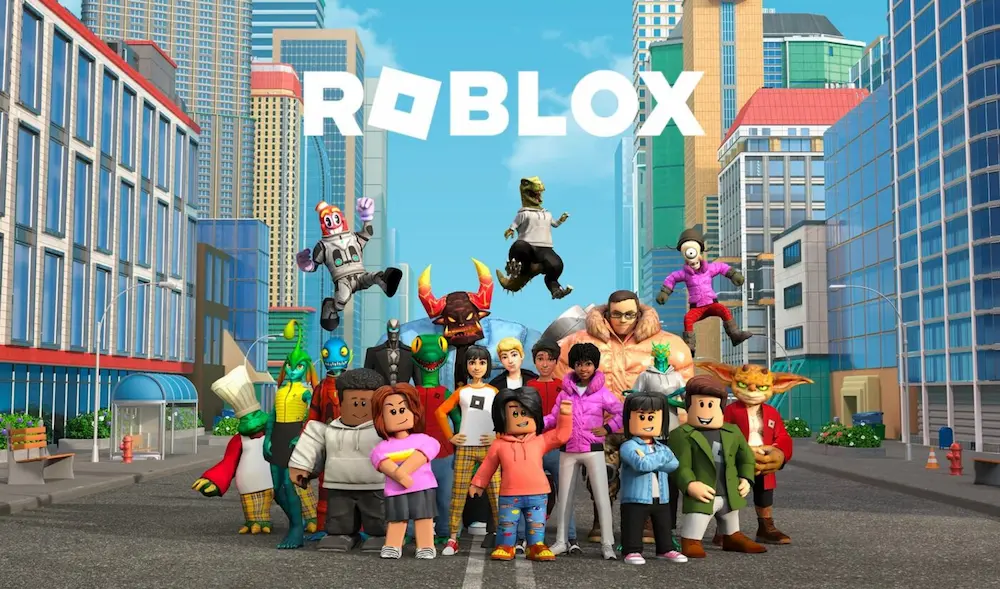
Description: Roblox is a massively popular online platform where users can create and play millions of immersive 3D experiences created by a global community of developers. While often categorized as a gaming platform, its vast array of social and interactive experiences positions it as a significant player in the evolving metaverse landscape, particularly among younger audiences.
Activities:
- Playing Millions of User-Created Games: The core of Roblox is its vast library of games spanning every imaginable genre, from adventure and role-playing to simulation and puzzle games. New experiences are constantly being created and shared by the community.
- Socializing and Connecting with Friends: Roblox is a highly social platform where users can connect with friends, join groups, and interact within the various experiences. Many games are designed for multiplayer interaction.
- Creating and Sharing Your Own Experiences: Roblox Studio provides users with the tools to design, build, and script their own games and virtual worlds. This empowers a massive community of young developers and creators.
- Customizing Avatars with a Wide Range of Items: Roblox offers a robust avatar customization system with a vast marketplace of clothing, accessories, and animations, allowing users to express their individual style.
- Attending Virtual Concerts and Events: Roblox has increasingly hosted major virtual concerts and events featuring popular artists, attracting millions of virtual attendees and showcasing the platform’s potential for large-scale metaverse experiences.
- Exploring Diverse Virtual Worlds and Communities: Beyond games, Roblox hosts a variety of virtual worlds focused on social interaction, exploration, and community building around shared interests.
- Participating in Virtual Economies: Roblox has a virtual currency called Robux, which users can earn or purchase and use to buy avatar items and enhance their in-game experiences. This fosters a significant virtual economy.
6. The Sandbox
Link: https://www.sandbox.game/en/
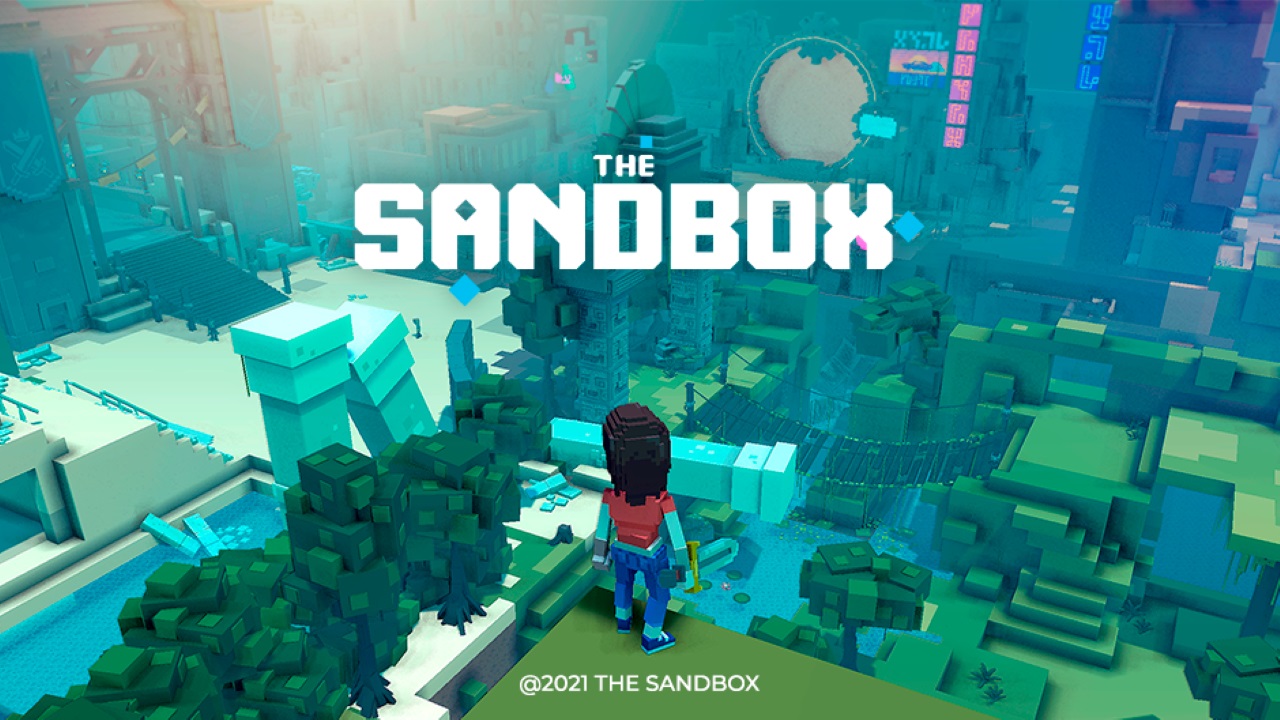
Description: The Sandbox is a decentralized, community-driven metaverse platform built on the Ethereum blockchain. It empowers users to create, own, and monetize voxel-based assets (NFTs) and gaming experiences. Land ownership (as NFTs) is a central element, allowing users to build experiences on their virtual plots.
Activities:
- Creating Voxel Assets with VoxEdit: Users can utilize The Sandbox’s free VoxEdit software to create and animate 3D voxel-based assets, such as characters, creatures, buildings, and items. These assets can then be minted as NFTs and traded on the platform’s marketplace.
- Building Experiences with Game Maker: The Sandbox’s Game Maker tool allows users to create interactive games and experiences on their virtual LAND without requiring coding knowledge. This empowers creators to design a wide variety of gameplay and interactive environments.
- Owning and Developing Virtual LAND: Virtual LAND in The Sandbox is represented by NFTs. Owners can develop their LAND by building experiences, hosting events, or renting it out to other creators. LAND ownership is a key aspect of the platform’s metaverse economy.
- Playing User-Generated Games and Experiences: The Sandbox features a growing library of games and interactive experiences created by its community. Users can explore these diverse creations and earn rewards.
- Trading NFTs on the Marketplace: The Sandbox has a built-in marketplace where users can buy and sell their created voxel assets (ASSETS) and virtual LAND (LAND) as NFTs. This fosters a vibrant creator economy.
- Participating in Decentralized Governance (DAO): The Sandbox has a decentralized autonomous organization (DAO) that allows SAND token holders to have a say in the platform’s future development and governance.
- Staking SAND Tokens: Users can stake their SAND tokens (the platform’s native cryptocurrency) to earn rewards and participate in the platform’s ecosystem.
- Attending Virtual Events and Social Gatherings: The Sandbox hosts virtual events, parties, and showcases within user-created LANDs, providing opportunities for social interaction and community engagement.
7. Decentraland
Link: https://decentraland.org/
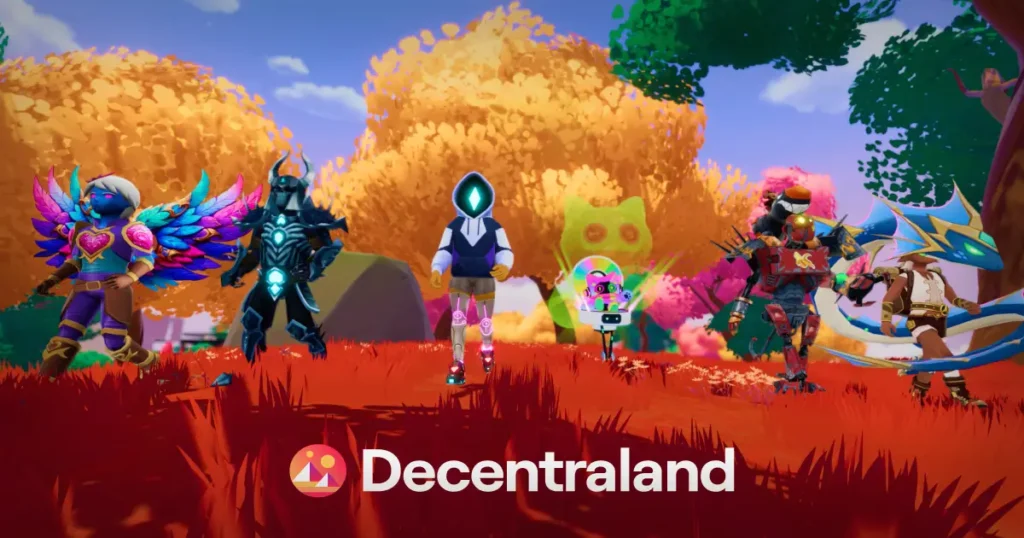
Description: Decentraland is a fully decentralized, user-owned virtual world built on the Ethereum blockchain. Like The Sandbox, virtual land (LAND) is represented by NFTs, giving users true ownership and control over their digital real estate. It emphasizes community governance and a user-driven economy.
Activities:
- Exploring a Decentralized Virtual World: Decentraland offers a vast and diverse virtual world to explore, featuring user-built environments, art galleries, casinos, music venues, and social hubs. Navigation is primarily done through web browsers.
- Owning and Developing Virtual LAND: LAND owners have complete control over their virtual plots and can build anything they imagine, from interactive games and businesses to art installations and social spaces.
- Creating and Monetizing Experiences: Users can create and monetize various experiences on their LAND, such as games, events, and virtual businesses. This can involve charging entry fees, selling virtual goods, or offering services.
- Trading LAND and Other Digital Assets: Decentraland has a marketplace where users can buy and sell virtual LAND, wearables for avatars, and other digital assets (NFTs).
- Participating in Decentralized Governance (DAO): The Decentraland DAO governs the platform’s policies, LAND auctions, and development proposals. MANA (the platform’s native cryptocurrency) and LAND holders have voting power.
- Attending Virtual Events and Gatherings: Decentraland hosts a wide range of virtual events, including music festivals, art exhibitions, conferences, and community meetups.
- Socializing and Connecting with Others: Users can interact with each other through voice and text chat as they explore the virtual world and participate in activities.
- Playing Games and Engaging in Interactive Experiences: Many LANDs host user-created games and interactive experiences, offering entertainment and opportunities to earn rewards.
8. Fortnite
Link: https://www.epicgames.com/fortnite/en-US/home
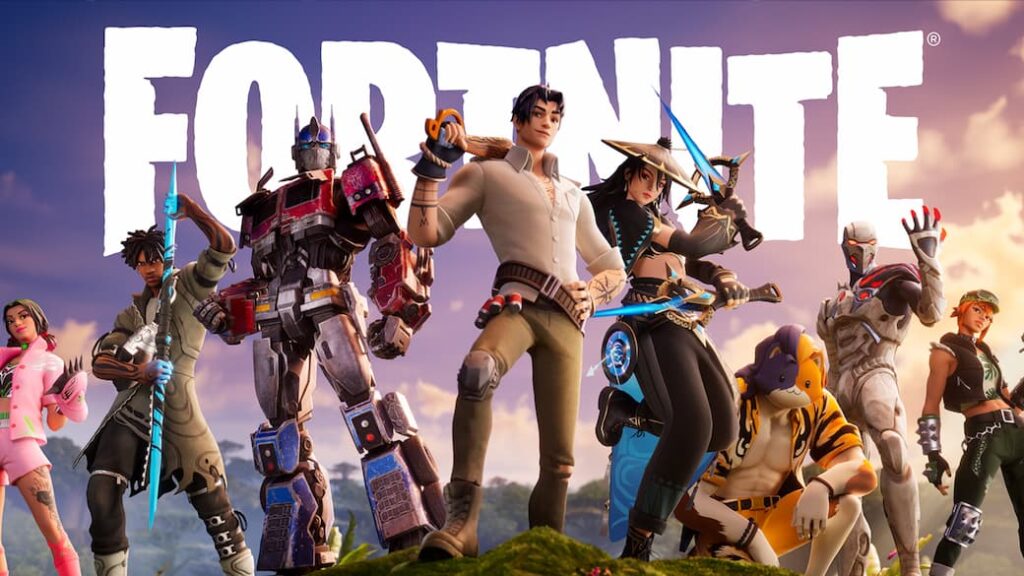
Description: While primarily known as a massively popular online video game, Fortnite has evolved significantly to incorporate metaverse elements, hosting large-scale virtual events, concerts, and social interactions within its evolving digital landscape. Its massive user base and cross-platform accessibility make it a significant player in the broader metaverse conversation.
Activities:
- Playing Battle Royale and Other Game Modes: The core of Fortnite remains its various game modes, including the iconic Battle Royale, Creative mode, and Save the World. These offer engaging and competitive experiences within the virtual environment.
- Attending Massive Virtual Concerts and Events: Fortnite has become a major platform for virtual concerts featuring world-renowned artists, attracting millions of concurrent viewers. These events often feature interactive elements and immersive visuals.
- Socializing and Connecting with Friends: Players can team up with friends to play games, explore the virtual world, and participate in events together. The platform offers various communication tools.
- Exploring an Evolving Virtual World: Fortnite’s map and lore constantly evolve with new seasons and updates, introducing new locations, characters, and storylines that keep the experience fresh.
- Creating and Sharing Experiences in Creative Mode: Fortnite Creative allows players to design and build their own islands and games using a wide array of tools and assets, fostering user-generated content within the platform.
- Participating in Brand Collaborations and Interactive Experiences: Fortnite frequently collaborates with major brands and franchises, integrating their characters and themes into the game and creating unique interactive experiences.
- Purchasing and Customizing Avatars (Skins) and Cosmetics: Players can personalize their in-game appearance with a vast array of skins, emotes, and other cosmetic items, contributing to a significant digital economy within the game.
Conclusion: Embracing the Dawn of Interconnected Digital Worlds
The metaverse is not a monolithic entity but rather a burgeoning ecosystem of diverse platforms, each offering unique ways to connect, create, and experience digital life. From immersive social VR worlds to decentralized blockchain-based economies and the evolving landscapes of popular games, the opportunities to step into these virtual realms are expanding rapidly.
Choosing which metaverse platform to join depends on your individual interests and technical capabilities. Whether you seek social connection, creative expression, gaming adventures, virtual commerce, or simply the chance to explore new digital frontiers, there is likely a metaverse platform that aligns with your desires.
As technology continues to advance and the vision of a more interconnected metaverse takes shape, understanding these foundational platforms and their unique offerings will be crucial for navigating the future of digital interaction. The journey into the metaverse has begun, and the possibilities are as vast and imaginative as the virtual worlds themselves.
